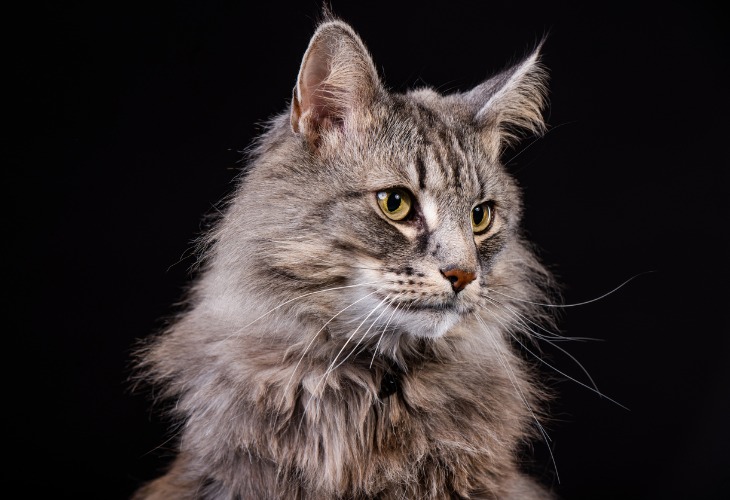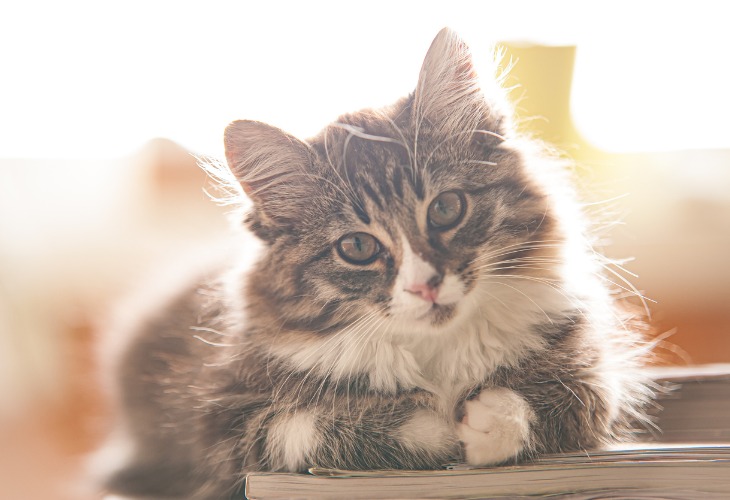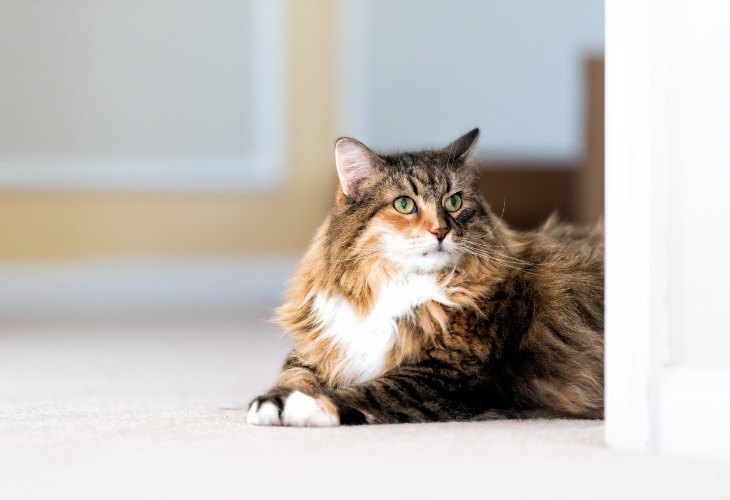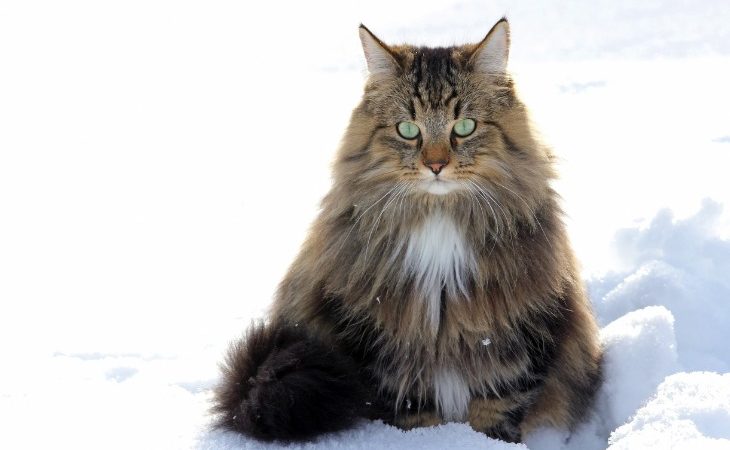Breed standard: CFA, FIFe, TICA, WCF, ACF, ACFA/CAA, CCA-AFC, GCCF I Size: Large I Average Lifespan: 12+ years I Temperament: Friendly and energetic I Coat: Long I Origin: Norway
The Norwegian Forest cat is a large, gentle, and intelligent cat.
Origin of the Norwegian Forest cat
The Viking cat
The Norsk Skogkatt, literally Norwegian Forest Cat, is a cat breed that originated in Northern Europe. Nowadays, the breed is popular in Iceland, Northern Europe, and France.
The Norwegian Forest cat has appeared in Norse mythology and Nordic folklore for centuries. In fact, the Norwegians even claim that this cat has always existed on their land. In the past, Vikings used these cats to protect their ships from rodent invasions. It is believed that a few Norwegian Forest cats decided to stay in America when a Vikings landed their ships there in 1000. Some people believe these traveling cats to be the first ancestors of the Maine Coon and the long-haired Manx.
Cross-breeding almost led to this breed’s extinction. Fortunately, at the end of the First World War, the Norwegian Forest Cat Club began working to save the Norsk Skogkatt. Their hard work was rewarded when the breed started appearing in cat shows in 1938 and when King Olaf V of Norway proclaimed the Norwegian Forest cat as the country’s official cat.
In the late 1970s, the breed began to be exported outside of Norway. The breed was officially recognized in Norway in 1972. The first Norwegian Forest cat to obtain a pedigree was Pan’s Truls in 1976. It was then used as a model to establish the standard of the breed.
Shaped by nature
The Norwegian Forest cat is a cat breed that adapts well to its environment. Its forest origins have shaped the breed’s body structure, making it strangely resemble the Lynx. Years of natural selection allowed the cat to adapt to the long and rigorous winters of Norway. This cat is robust, with a protective and water-resistant coat and a woolly undercoat necessary to survive the harsh climates of its native land.
Its entire body is designed to withstand cold temperatures. For example, the Norwegian Forest cat’s ears are positioned low on the skull to avoid excessive heat loss. Its paws are also tufted to provide a layer of warmth between the pads and the cold ground.

The Norwegian Forest cat’s personality
The qualities of the Norwegian Forest cat
Despite the breed’s wild appearance, the Norwegian Forest cat is a homebody. They love to spend time with humans and other animals. They are also an excellent cat for children, as they are faithful and gentle. This breed is very friendly and lets everyone into its circle. They are typically not shy towards visitors and strangers.
This particularly talkative breed likes to draw attention to itself.
The Norwegian Forest cat is patient, intelligent, and naturally curious. For this reason, the breed is often considered a “cat-dog”.
This cat loves to climb trees and can climb down trees headfirst! This is one of the Norwegian Forest cat’s unique abilities.
A garden with enough room for it to practice jumping and climbing is ideal. When indoors, this breed will appreciate anything to climb on, such as large cat towers or high furniture.
The shortcomings of the Norwegian Forest cat
While the Norwegian Forest cat is not a stressed cat, it can suffer from loneliness. Do not be surprised if this cat sticks to you like glue. They love to follow their humans around. Though soft and cuddly, this breed will not necessarily sit on your lap. They prefer to sit close to you instead.

Physical characteristics of the Norwegian Forest cat
General appearance
The breed is fully grown around the age of five years, as with all large cat breeds.
To avoid confusion between the Maine Coon and the Norwegian Forest cat, Norwegian breeders modified the standard in 1987 to better distinguish between the two breeds.
The Norwegian Forest cat’s head
The skull is triangle-shaped with a slightly rounded forehead. Its profile is straight and long. The breed’s chin is strong, firm, and square and their nose is medium length.
Norwegian Forest cats have magnificently large almond-shaped eyes. All eye colors are allowed in the breed, no matter the color of the coat. That being said, emerald eyes are amonst the rarest of the eye colors.
The ears are large, broad at the base, and are arched forward with long hairs protruding from the ears.
The Norwegian Forest cat’s body
This breed is heavy-boned and long. It is a large cat breed, known for its magnificence and power.
Their legs are strong and long, with their hind legs being slightly longer than their front legs. Their paws are heavily tufted between the pads to provide warmth during the cold winters.
The breed’s tail is long and fluffy, spreading out like a feather.

Coat, color, and grooming
The Norwegian Forest cat coat
The Norwegian Forest cat has a double coat: a woolly undercoat and a long waterproof top layer. The undercoat forms a sort of “underwear” on the back of the cat’s thighs. This underwear is also referred to as “knickers”. At the neck, the coat forms thick and warm collar.
The Norwegian Forest cat colors
While most colors are allowed in Norwegian Forest cat, colors such as Lilac, Chocolate, Amber, Fawn, Oriental Pointed pattern, and Cinnamon are not.
Grooming tips
A simple weekly brushing will be enough to rid the Norwegian Forest cat of its dead hairs. Nevertheless, it is important to meticulously remove knots.
During its annual moulting period, it is necessary to brush the cat more often. However, pay special attention to the tail. These hairs take longer to grow back if they are pulled out during brushing.
Fun facts about the Norwegian Forest cat
- The Norwegian does not purr, it coos!
- In Norse mythology, the Skogkatt is considered to be half-cat, half-god. He is so strong that even the god of thunder, Thor, fails to lift it. Freyja, the goddess of love, even uses Norwegian Forest cats to pull her wagon.
- The Norwegian Forest cat is also commonly referred to as a “wegie”.
The Norwegian Forest cat at a glance
Size: 35 centimeters (13 inches).
Weight: 4-7 kilograms (9-16 pounds).
Health: Similar to other pedigree cats, inbreeding can sometimes give rise to diseases such as cardiomyopathy or hip dysplasia.
Are Norwegian Forest cats good with children? Attentive, faithful and gentle — this cat breed is perfect for families with children.
How easy are Norwegian Forest cats to live with? The Norwegian Forest cat is calm, playful, curious, patient, and affectionate. They are dependant and do not appreciate being left alone for too long. While the breed adapts very well to apartment life, they will always appreciate having large cat towers to satisfy their natural instinct to climb.

